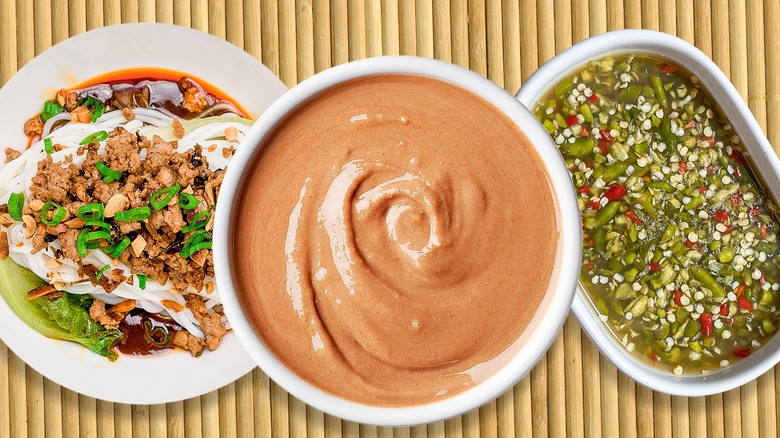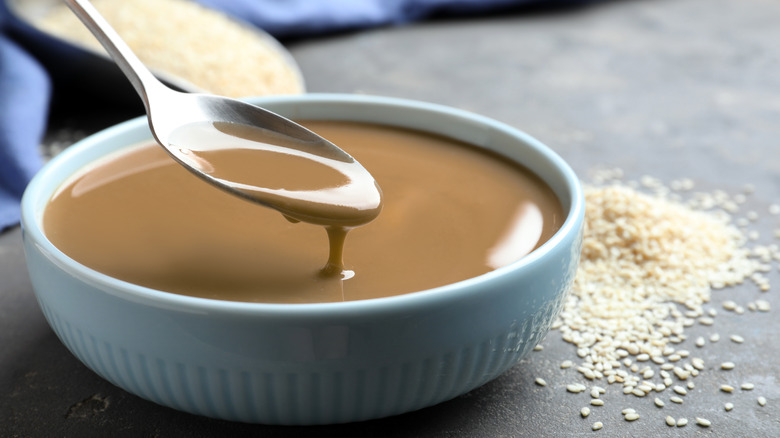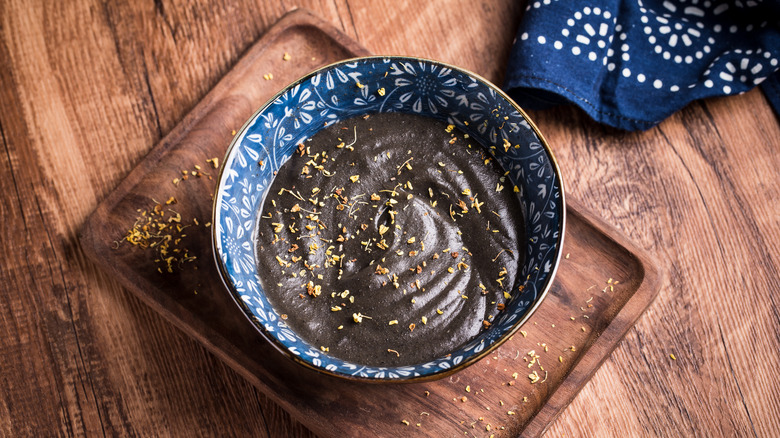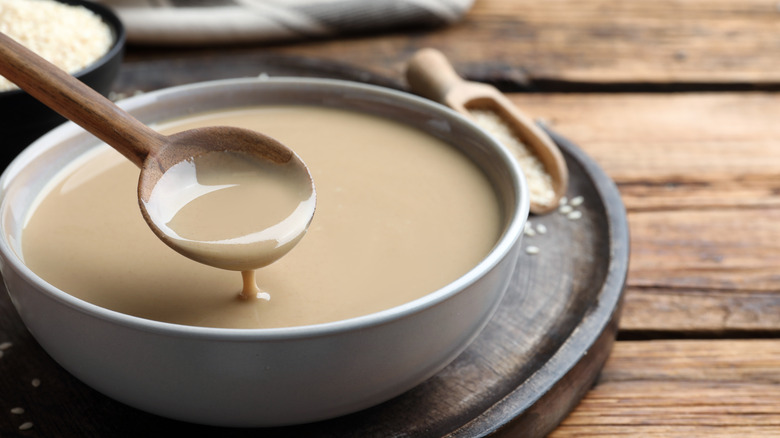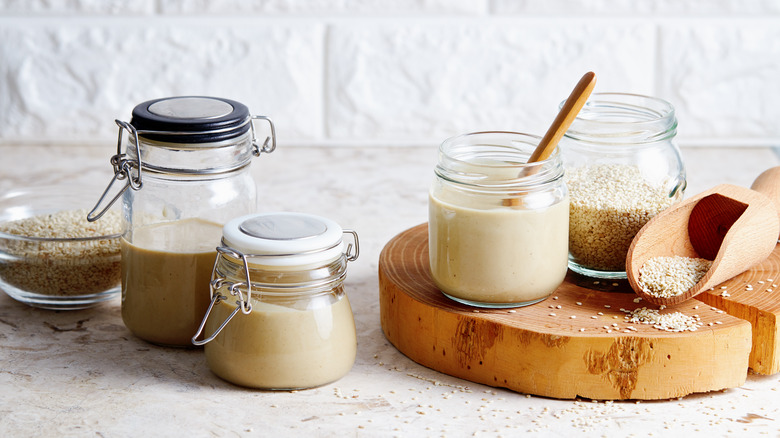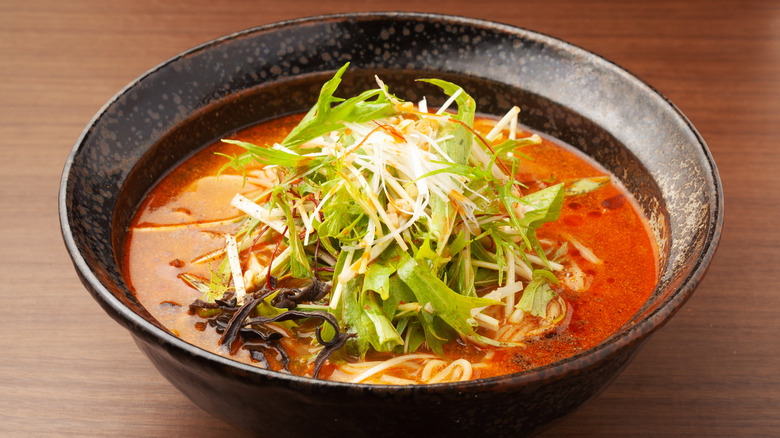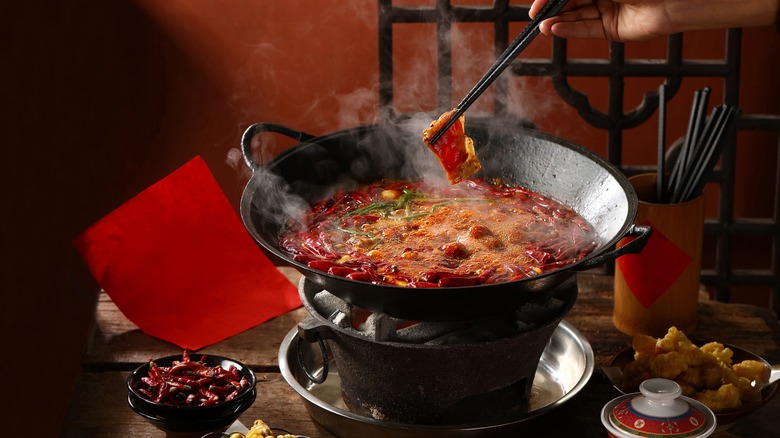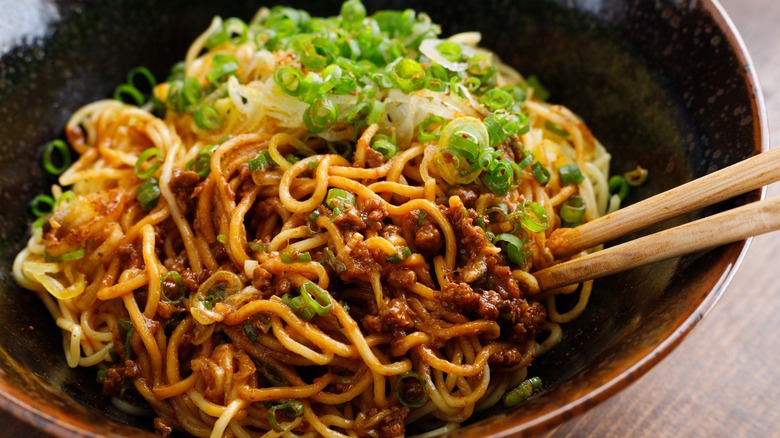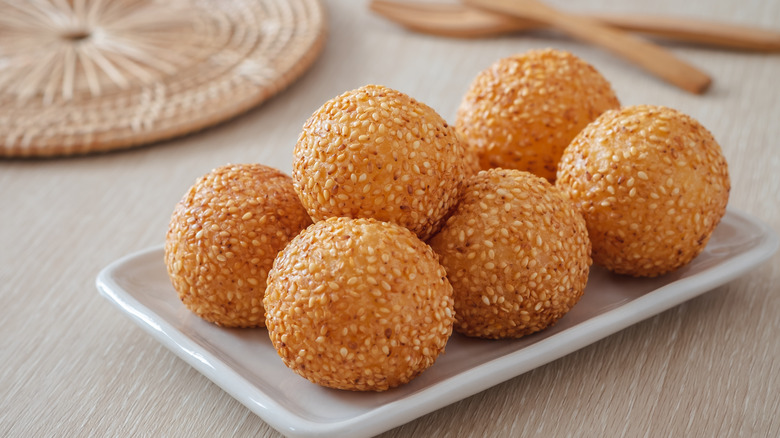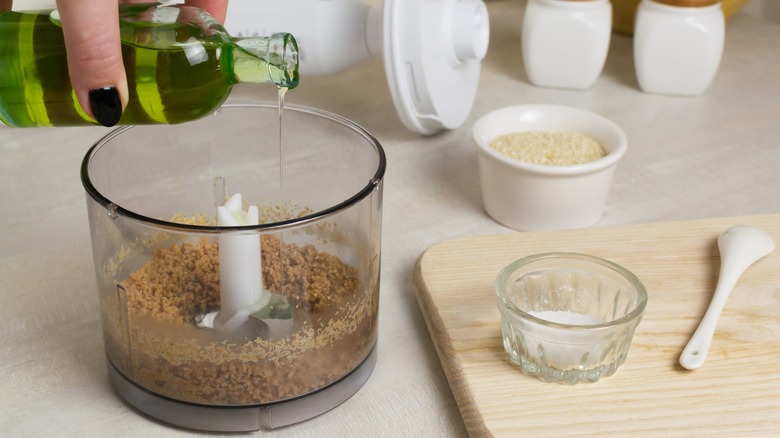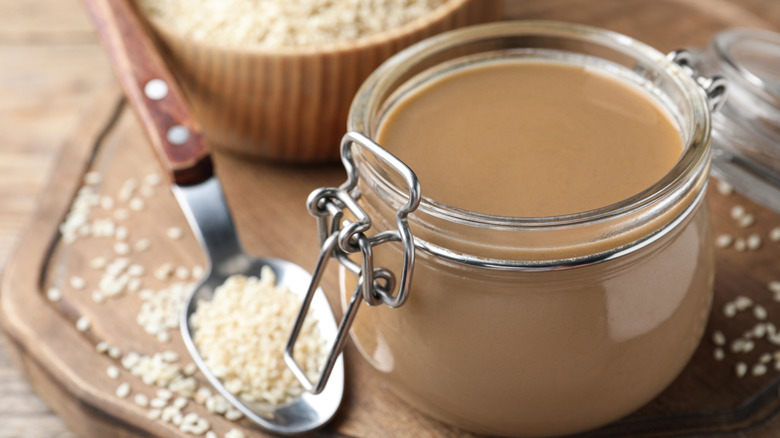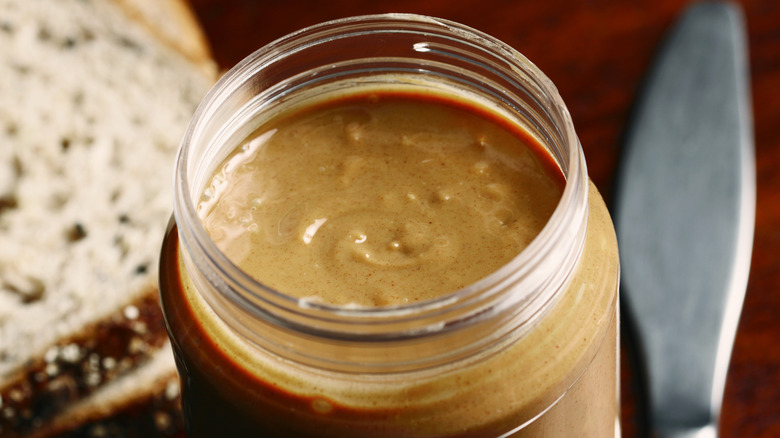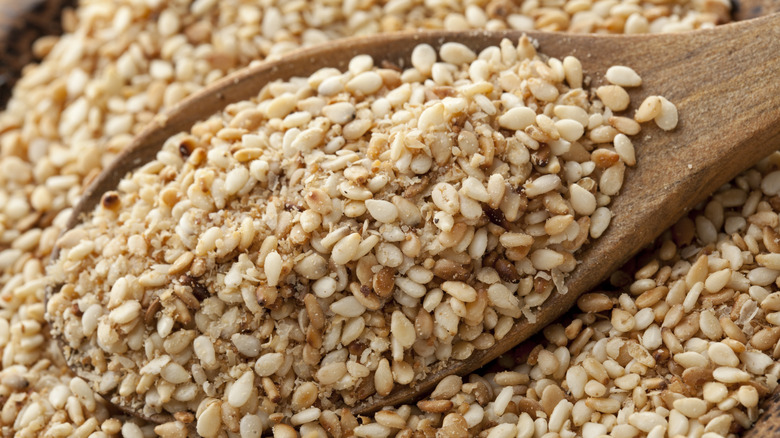What Is Chinese Sesame Paste And How To Utilize It In Your Recipes
If you've ever indulged in a plate of spicy dan dan noodles or slurped on a bowl of spicy tantanmen ramen, you know the characteristic flavor of Chinese sesame paste: rich, nutty, smoky, and indescribably complex. What exactly is Chinese sesame paste? How can you harness its incredible flavor to perfect recipes or innovate fusion dishes guaranteed to leave friends and family speechless? Are there viable substitutes, or can you prepare this special ingredient at home?
Fear not — our comprehensive guide has all the answers and then some. From decoding the science of Chinese sesame paste to unlocking its full potential in your kitchen, we leave no stone unturned. By the time you reach the final section, you'll not only be an expert on the ins and outs of the Asian condiment but also armed with the confidence to use it.
What is Chinese sesame paste?
Called zhī ma jiàng in Mandarin, neri goma in Japanese, Chinese sesame paste is a type of seed butter essential for many foundational Chinese dishes. The thick, honey-brown-colored paste is made from sesame seeds, which have been thoroughly washed, dried, and then toasted until deep brown in color and aromatic. The last stage is blending them with sesame oil, resulting in a velvety smooth, deeply smoky, and unbelievably nutty condiment.
While many Western cooks may be unfamiliar with the sauce, contrastingly, every Chinese home cook is likely to have a jar of sesame seed paste in the pantry. It's an indispensable mainstay used almost daily to whip up dipping sauces, noodles, or desserts quickly. Undeniably rich and satisfying, it's no wonder it's become so widespread among Asian cooks; the sesame paste complements the famously savory umami notes Chinese cuisine is known for, offsets the tangy, funky flavors of fermentation, balances out spicier elements of the dishes and works equally well sweetened up. In short, it's an ideal all-rounder powerhouse for your pantry.
Types of Chinese sesame paste
Before we delve further, let's address the elephant in the room. There are two styles of sesame paste typically associated with Chinese cuisine: zhī ma jiàng (white sesame paste) and hēi zhī má xiàn (black sesame paste). Both are equally widespread across China — and indeed beyond China's borders, in Japan and Korea too — but while cooks generally use white sesame paste for savory dishes, black sesame paste is a prized addition to desserts.
Traditional black sesame paste blends the toasted unhulled seeds with oil, then mixes in a sweetener (ordinarily honey). The resulting paste is nutty, thick, and sweet — ideal for making black sesame ice cream, irresistible stuffed buns, or traditional breakfast delicacies like tong sui, a Cantonese sweet black sesame soup. If the idea of rustling up these recipes isn't enough to tempt you into adding black sesame paste to your pantry, we don't know what is.
While both types of paste are occasionally called "Chinese sesame paste," the term is more commonly associated with the widely available variety, which is the focus of this article: white sesame paste. To avoid confusion, always specify the color of the sesame paste. Luckily, they're easy to tell apart by sight!
Chinese sesame paste vs tahini
Have you ever savored a kebab smothered in garlicky tahini sauce? How about making a batch of creamy homemade hummus for pita chips? We're guessing yes — and if so, you'll be familiar with tahini. It's a rich, nutty, and sumptuously oily sauce native to the Middle East, where it's a vital ingredient for traditional treats like halva or baba ghanoush. It's easy to whip up the iconic sesame paste: de-hull the seeds (remove the outer skin), then blend them with oil, producing a creamy, nutty, and comparatively mild sauce.
Conversely, zhī ma jiàng exclusively uses unhulled sesame seeds. Sesame seeds with intact skins have a denser, coarser texture and deliver a more assertive flavor profile, often characterized by subtle bitter notes absent in the hulled seeds typically used for tahini. Additionally, Chinese sesame paste requires the cook to toast the seeds before blending them with oil, further intensifying the flavor.
While you can substitute one for the other in some instances (we'll cover this more later), it's crucial to recognize these aren't two different names for the same product but two independent condiments from different cultures, where a few differences create a notable diversity of taste. Remember, in the world of cooking, nothing is ever simple. Sesame paste isn't just sesame paste — and there is a difference between sesame paste and tahini.
Not all sesame paste is made equally
It's always a good idea to read the ingredient lists carefully. This advice rings true in the case of Chinese sesame paste, which notoriously varies not just in taste and texture but also in ingredients. While you'd expect the jars to contain just sesame seeds and sesame oil, that's not always the case; some companies use soybean oil instead of sesame oil — while the latter increases the nutty intensity of zhī ma jiàng, soybean oil produces a light, fresher, and more subtle tasting product thanks to its neutral overtones.
The oil blend is perhaps the add-in you should be least concerned about. Due to the expense of sesame seeds, it's not uncommon to see soybeans added to the jars to bulk out the Chinese sesame paste — shockingly, sometimes in much larger quantities than the sesame seeds themselves. Although the soybeans themselves don't affect the flavor substantially, it does result in your jar containing an overall less impactful sauce, meaning you'll have to use more of the specialist ingredient to achieve the right taste. Plus, it's not suitable for people with soy allergies.
Furthermore, some brands also include peanuts, which, unlike soybeans, substantially alter the taste of the paste, making it sweeter and creamier. It's crucial to note that if you have a tree-nut allergy, you can typically enjoy sesame seed paste — but not when it has added peanuts. In short, we recommend seeking the purest Chinese sesame paste possible, to ensure the best culinary experience.
Use it to make spicy tantanmen
With a jar of Chinese sesame paste in your kitchen, there's no limit to the irresistible dishes you can cook, though undoubtedly one of the most beloved recipes featuring the ingredient is tantanmen ramen (or tan tan ramen). "Ramen?" you may question — indeed! Despite its popularity in Japan now, this dish traces its roots back to classic Sichuan Chinese recipes and flavors, including a tare (ramen base) made from a delightful mix of zhī ma jiàng, miso, vinegar, rich soy sauce, and fiery chili oil.
If you love spice, this is the recipe for you. Entirely different from typical Japanese ramen, the sesame paste adds a complex nuttiness to the creamy soy milk broth, while spicy bean paste and chili oil ramp up the heat. In homage to its culinary roots — dan dan noodles — we complete the ramen with a succulent mince stir-fried with aromatics like ginger and garlic, alongside numbing Sichuan peppercorns and umami-packed mainstays like soy sauce. All you need to complete the bowls is freshly boiled ramen noodles, greens (pak choy is ideal), and a runny boiled egg to add extra richness to the broth. Trust us; adding Chinese sesame paste to ramen is a game-changer, and you won't look back.
It's a traditional ingredient in hot pot sauce
Hot pot is the ultimate community meal. Imagine one large pan full to the brim with expertly seasoned stock bubbling away. Around the pot is an array of raw ingredients, including fish, meats, vegetables, noodles, and tofu — beancurd rolls, beef flank, lotus roots, and Chinese broccoli, to name just a few, are some favorites. People throw them in the hot stock, cook them to perfection, then dunk them in a personalized dipping sauce. The hot pot experience is 100% customizable, ranging from vegetarian to carnivorous feast, blow-your-socks-off-spicy to mild and aromatic.
Traditionally, the focus of the hot pot was all in the soup base. But, with the advent of all-you-can-eat hot pot restaurants worldwide, that's all changed. Now, you'll see condiment stations full of scallions, sauces, and aromatics you can mix to make the perfect sauce. A recent viral hot pot sauce hack included a large dollop of Chinese sesame paste, and it turns out that's a fashionable choice.
Chinese sesame paste provides an excellent base for dipping sauce: it's thick and hearty, instantly adding dollops of flavor to anything dipped in it. Start by thinning the sesame paste with hot water, then jazz it up with garlic, oyster sauce, freshly chopped scallions, zesty cilantro, and other ingredients to taste.
Stir-fry a batch of dan dan noodles
Sesame paste is at the heart of one of the most beloved Chinese takeout dishes: dan dan noodles. The iconic dish gets its name from a long bamboo pole balanced on the shoulders of merchants, which would have pots of noodles hanging from either side.
To make the dish, sear pork mince with preserved mustard greens, fermented bean paste, salty soy sauce, Shaoxing cooking wine, and fresh scallions. Complete the dish by tossing fresh noodles with the tender mince, plus a sauce boasting Chinese sesame paste, sugar, minced garlic, spicy Sichuan peppercorn, cinnamon, chili, and anise-infused oil. Dan dan noodles are a powerfully savory dish with complex flavors that meld together perfectly, highlighting the complexity of the thick, dark sesame paste.
If using numerous specific ingredients in a recipe doesn't appeal to you, there's another option: you can utilize Chinese sesame paste to prepare authentic Shanghai sesame noodles. We toss the noodles in a silky sauce featuring nutty sesame paste, peanut butter, sugar for sweetness, rice vinegar for tanginess, light soy sauce, and chili oil for a spicy kick. The ingredients may be minimal, but the flavors are anything but. Ultimately, whichever noodle dish you choose, you'll make it so regularly you'll go through countless jars of sesame paste before you know it.
Don't limit yourself to savory dishes
While black sesame paste may be the top dessert choice for many, there's plenty of room to get creative with zhī ma jiàng. When there are options like the traditional Chinese sesame seed dessert, jian dui, and fusion delights like chewy cookies or swirled brownies, why limit the usage of Chinese sesame paste to savory dishes?
Just like experimental chefs mix tahini into a range of desserts, you can use the richer Asian condiment similarly. Before you start adding it to dishes, remember a little goes a long way, so use it sparingly. A spoonful can elevate recipes like cheesecake, gooey fudge, moist cake, or gooey skillet cookies; the nutty taste and thick, oily texture does wonders for baked goods.
If you're hesitant about incorporating the savory paste into your favorite desserts, consider this alternative: lightly drizzle a small amount over vanilla ice cream, steamed pudding, or even fluffy Japanese-style pancakes.
Where to buy Chinese sesame paste
If you think everything we've written about here sounds fantastic, you'll want to add Chinese sesame paste to your kitchen pronto. The only question is, where can you buy zhī ma jiàng? Thankfully, there should be no trouble finding well-stocked shelves of these jars at your local pan-Asian grocery store. Depending on your location, you might need to search more, but nationwide chains like H-Mart or 99 Ranch Market are reliable options. Additionally, stores like Hong Kong Supermarket, Kam Man Food, and Lion Supermarket, while fewer in number, should also carry a range of sesame paste brands.
Plus, if you're lucky enough to live near a city with a bustling Chinatown district, there are likely to be numerous hidden gems just waiting to be discovered — ones that will surely stock the specialty ingredient. Don't hesitate to seek assistance from a store assistant if you need help to find the Chinese sesame paste.
On the other hand, if you reside in a rural area without any Asian grocery stores nearby, it's wise to explore online options. Many stores offer a wide selection of products for delivery, and you can also check platforms like Amazon for availability.
How to make Chinese sesame paste at home
Making homemade Chinese sesame paste is more straightforward than you could ever believe. It only requires a few minutes, a basic blender, and two easily accessible ingredients. Even novice cooks can easily replicate store-bought Chinese sesame paste, even without any prior cooking experience or fancy ingredients, making it the ideal option when, for whatever reason, it's not possible to purchase the condiment.
Start with a packet of unhulled sesame seeds. They'll be slightly darker than typically seen on burger buns or bagels, often go by the term "natural sesame," and can often be found in organic or health food stores. Once you have the sesame seeds in hand, take a thick-bottomed frying pan and dry-toast over medium heat, stirring frequently, until they smell fragrant and change color to a deep golden. Remove from the heat and cool, then transfer to a blender or food processor along with sesame oil. Let the mixture pulse until it starts to incorporate, slowly adding more sesame oil until a smooth, silky paste forms. Chinese sesame paste is customarily thicker than tahini, but it should still be runny; you can also add salt to taste.
How to store sesame paste
Now that you've got your hands on this nutty Asian condiment and tried it in your first recipe, you might wonder, "Where should I store Chinese sesame paste?" The answer isn't as simple as you might think. There are two schools of thought — one recommends storing the sauce somewhere cool and dark, while another explicitly recommends the refrigerator.
Chinese sesame paste possesses a high oil content, similar to tahini (and other seeds or nut butter). This oil helps give the condiment a rich and unctuous mouthfeel, in addition to preserving the ingredients — but it can also cause problems. If stored in the pantry, the seed butter can separate, with the oil forming a layer on top, while the creamy sesame seed paste settles below. This effect not only makes it harder to use in recipes, as it requires rigorous stirring beforehand, but also risks the oil going rancid.
On the other hand, storing Chinese sesame paste in the refrigerator slows oil separation and may increase the product's shelf life, but it's not without faults. The sesame paste can harden into an almost solid state, making it awkward to cook and mix into recipes. Ultimately, either option is safe — we would err on the side of caution and choose to refrigerate the paste, then let it come to room temperature 30 minutes before cooking to loosen up.
Chinese sesame paste substitutes
Can't get your hands on the gourmet ingredient? You'll be happy to know several suitable alternatives for Chinese sesame paste you can turn to if needed. The closest switch is tahini — although, due to its lighter flavor, we advise adding more than a recipe originally calls for. Alternatively, to deliver an extra savory boost, add a drizzle of homemade sesame oil to the tahini. Although it won't have a comparable nuance or depth, the fundamental flavor notes are present, making it an acceptable option. Avoid tahini with olive oil listed as an ingredient; it will overpower other flavors, and the grassiness doesn't complement Asian seasonings. Furthermore, we advocate for lightly toasted (not raw) tahini; it has an improved aroma and complexity.
Another workable substitute is one you probably already have in your pantry: peanut butter. As one of the most widespread nut butter, it's accessible and affordable, making it one of the most practical options. Because peanuts go through a caramelization process before being blended into the creamy nut butter, they maintain a toasted and nutty fragrance, equivalent to authentic zhī ma jiàng. Here are three critical points to consider when using this substitute: Firstly, peanut butter may not be suitable for those with nut allergies. Secondly, it's best to choose smooth peanut butter over chunky varieties. Lastly, avoid sweetened peanut butter, as the added sugar can disrupt the flavor balance in your recipes.
Nutrition of Chinese sesame paste
Sesame seeds are widely acknowledged to host myriad benefits — including high levels of dietary fiber, a surprising dose of plant-based protein, and bone-enriching calcium, amongst other things. The only problem is you need to eat sesame seeds in large amounts to feel the full extent of their advantages. Luckily, Chinese sesame paste is a tasty and healthy way to eat far more sesame seeds than you would if you were solely using them as a garnish.
And that's not all. Because Chinese sesame paste uses unhulled seeds, it's blessed with even more nutrients, as, for the most part, the nutrients concentrate within the seed's skin. A few of the principal nutrients found in unhulled sesame seeds are B vitamins, essential for a healthy functioning metabolism; iron (twice the amount compared to hulled seeds); magnesium, which regulates blood pressure; and selenium, which aids in thyroid health. Additionally, roasting the seeds — an essential step in making Chinese sesame paste — aids in absorbing vital minerals and vitamins even further.
However, there are downsides to the less processed seeds, too. For example, since the hull contains more oxalates, it's harder for the body to digest the protein in the paste. Even so, sesame seeds can substantially add to a balanced protein intake, particularly for vegetarians and vegans. In conclusion, Chinese sesame paste is a beneficial, wholesome addition to a balanced diet and likely offers more benefits compared to other comparative products like tahini.
Static Media owns and operates Mashed and Tasting Table.
